Organizational Development: Diagnosing Groups and Jobs at Perodua
VerifiedAdded on 2022/10/04
|13
|3485
|285
Report
AI Summary
This report delves into the critical process of diagnosing groups and jobs within organizations, using Perodua, a Malaysian automobile manufacturer, as a case study. It begins by highlighting the significance of diagnosis in organizational change management, emphasizing its role in identifying performance gaps and facilitating improvements in structure, technology, and human resource processes. The report then outlines the importance of group and individual-level diagnosis for Perodua, detailing how these analyses can inform strategic decisions and support the company's growth. The core of the report focuses on the diagnostic process, breaking down the input, design components, and output elements at both the group and individual job levels. It also presents a diagnostic model for individual jobs, illustrating how factors like organizational design, group dynamics, and personal traits influence job performance and organizational development. Finally, the report underscores the practical application of the diagnostic model, emphasizing its utility in enhancing individual contributions, improving organizational effectiveness, and managing change within Perodua.
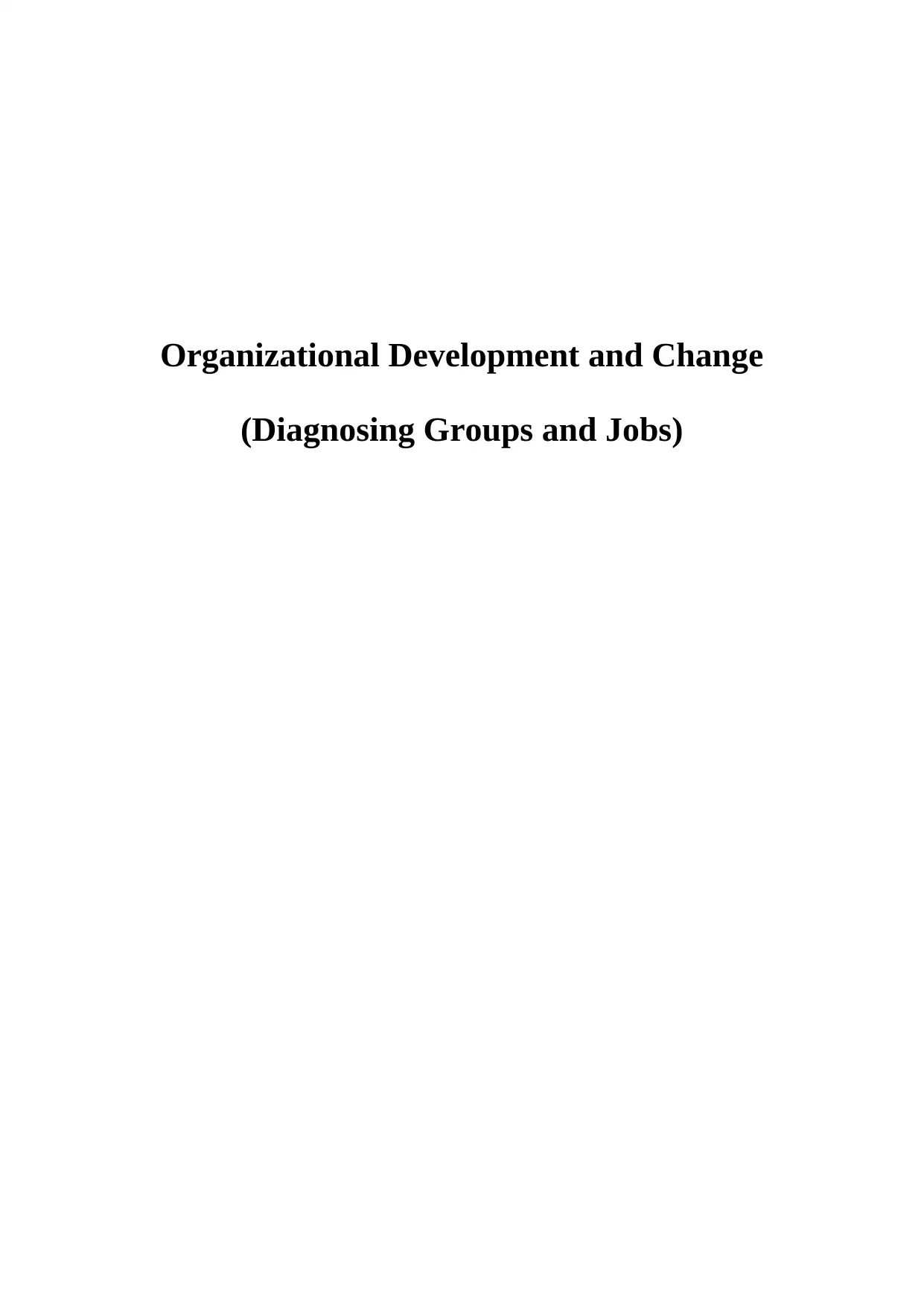
Organizational Development and Change
(Diagnosing Groups and Jobs)
(Diagnosing Groups and Jobs)
Paraphrase This Document
Need a fresh take? Get an instant paraphrase of this document with our AI Paraphraser
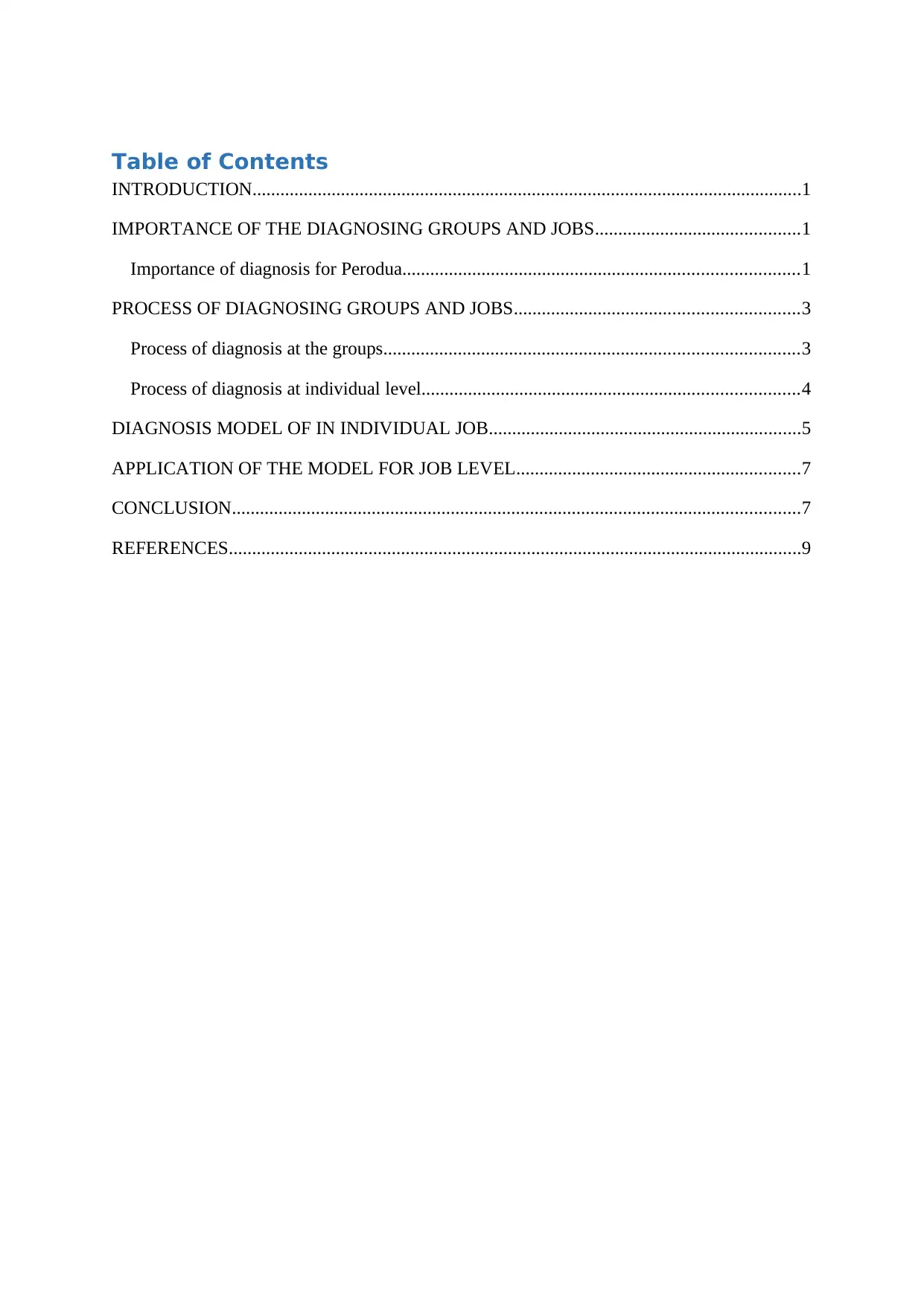
Table of Contents
INTRODUCTION......................................................................................................................1
IMPORTANCE OF THE DIAGNOSING GROUPS AND JOBS............................................1
Importance of diagnosis for Perodua.....................................................................................1
PROCESS OF DIAGNOSING GROUPS AND JOBS.............................................................3
Process of diagnosis at the groups.........................................................................................3
Process of diagnosis at individual level.................................................................................4
DIAGNOSIS MODEL OF IN INDIVIDUAL JOB...................................................................5
APPLICATION OF THE MODEL FOR JOB LEVEL.............................................................7
CONCLUSION..........................................................................................................................7
REFERENCES...........................................................................................................................9
INTRODUCTION......................................................................................................................1
IMPORTANCE OF THE DIAGNOSING GROUPS AND JOBS............................................1
Importance of diagnosis for Perodua.....................................................................................1
PROCESS OF DIAGNOSING GROUPS AND JOBS.............................................................3
Process of diagnosis at the groups.........................................................................................3
Process of diagnosis at individual level.................................................................................4
DIAGNOSIS MODEL OF IN INDIVIDUAL JOB...................................................................5
APPLICATION OF THE MODEL FOR JOB LEVEL.............................................................7
CONCLUSION..........................................................................................................................7
REFERENCES...........................................................................................................................9
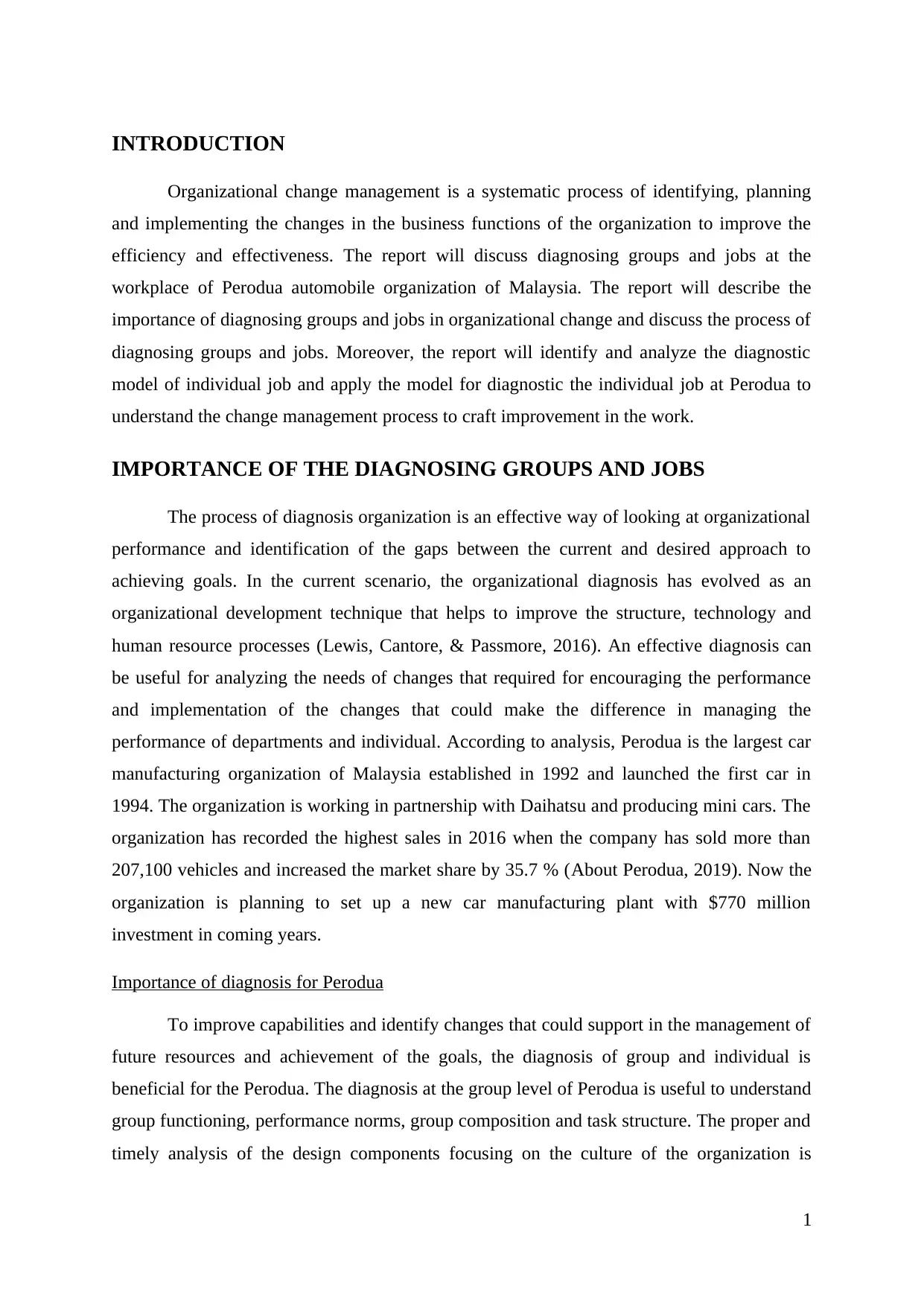
INTRODUCTION
Organizational change management is a systematic process of identifying, planning
and implementing the changes in the business functions of the organization to improve the
efficiency and effectiveness. The report will discuss diagnosing groups and jobs at the
workplace of Perodua automobile organization of Malaysia. The report will describe the
importance of diagnosing groups and jobs in organizational change and discuss the process of
diagnosing groups and jobs. Moreover, the report will identify and analyze the diagnostic
model of individual job and apply the model for diagnostic the individual job at Perodua to
understand the change management process to craft improvement in the work.
IMPORTANCE OF THE DIAGNOSING GROUPS AND JOBS
The process of diagnosis organization is an effective way of looking at organizational
performance and identification of the gaps between the current and desired approach to
achieving goals. In the current scenario, the organizational diagnosis has evolved as an
organizational development technique that helps to improve the structure, technology and
human resource processes (Lewis, Cantore, & Passmore, 2016). An effective diagnosis can
be useful for analyzing the needs of changes that required for encouraging the performance
and implementation of the changes that could make the difference in managing the
performance of departments and individual. According to analysis, Perodua is the largest car
manufacturing organization of Malaysia established in 1992 and launched the first car in
1994. The organization is working in partnership with Daihatsu and producing mini cars. The
organization has recorded the highest sales in 2016 when the company has sold more than
207,100 vehicles and increased the market share by 35.7 % (About Perodua, 2019). Now the
organization is planning to set up a new car manufacturing plant with $770 million
investment in coming years.
Importance of diagnosis for Perodua
To improve capabilities and identify changes that could support in the management of
future resources and achievement of the goals, the diagnosis of group and individual is
beneficial for the Perodua. The diagnosis at the group level of Perodua is useful to understand
group functioning, performance norms, group composition and task structure. The proper and
timely analysis of the design components focusing on the culture of the organization is
1
Organizational change management is a systematic process of identifying, planning
and implementing the changes in the business functions of the organization to improve the
efficiency and effectiveness. The report will discuss diagnosing groups and jobs at the
workplace of Perodua automobile organization of Malaysia. The report will describe the
importance of diagnosing groups and jobs in organizational change and discuss the process of
diagnosing groups and jobs. Moreover, the report will identify and analyze the diagnostic
model of individual job and apply the model for diagnostic the individual job at Perodua to
understand the change management process to craft improvement in the work.
IMPORTANCE OF THE DIAGNOSING GROUPS AND JOBS
The process of diagnosis organization is an effective way of looking at organizational
performance and identification of the gaps between the current and desired approach to
achieving goals. In the current scenario, the organizational diagnosis has evolved as an
organizational development technique that helps to improve the structure, technology and
human resource processes (Lewis, Cantore, & Passmore, 2016). An effective diagnosis can
be useful for analyzing the needs of changes that required for encouraging the performance
and implementation of the changes that could make the difference in managing the
performance of departments and individual. According to analysis, Perodua is the largest car
manufacturing organization of Malaysia established in 1992 and launched the first car in
1994. The organization is working in partnership with Daihatsu and producing mini cars. The
organization has recorded the highest sales in 2016 when the company has sold more than
207,100 vehicles and increased the market share by 35.7 % (About Perodua, 2019). Now the
organization is planning to set up a new car manufacturing plant with $770 million
investment in coming years.
Importance of diagnosis for Perodua
To improve capabilities and identify changes that could support in the management of
future resources and achievement of the goals, the diagnosis of group and individual is
beneficial for the Perodua. The diagnosis at the group level of Perodua is useful to understand
group functioning, performance norms, group composition and task structure. The proper and
timely analysis of the design components focusing on the culture of the organization is
1
⊘ This is a preview!⊘
Do you want full access?
Subscribe today to unlock all pages.

Trusted by 1+ million students worldwide
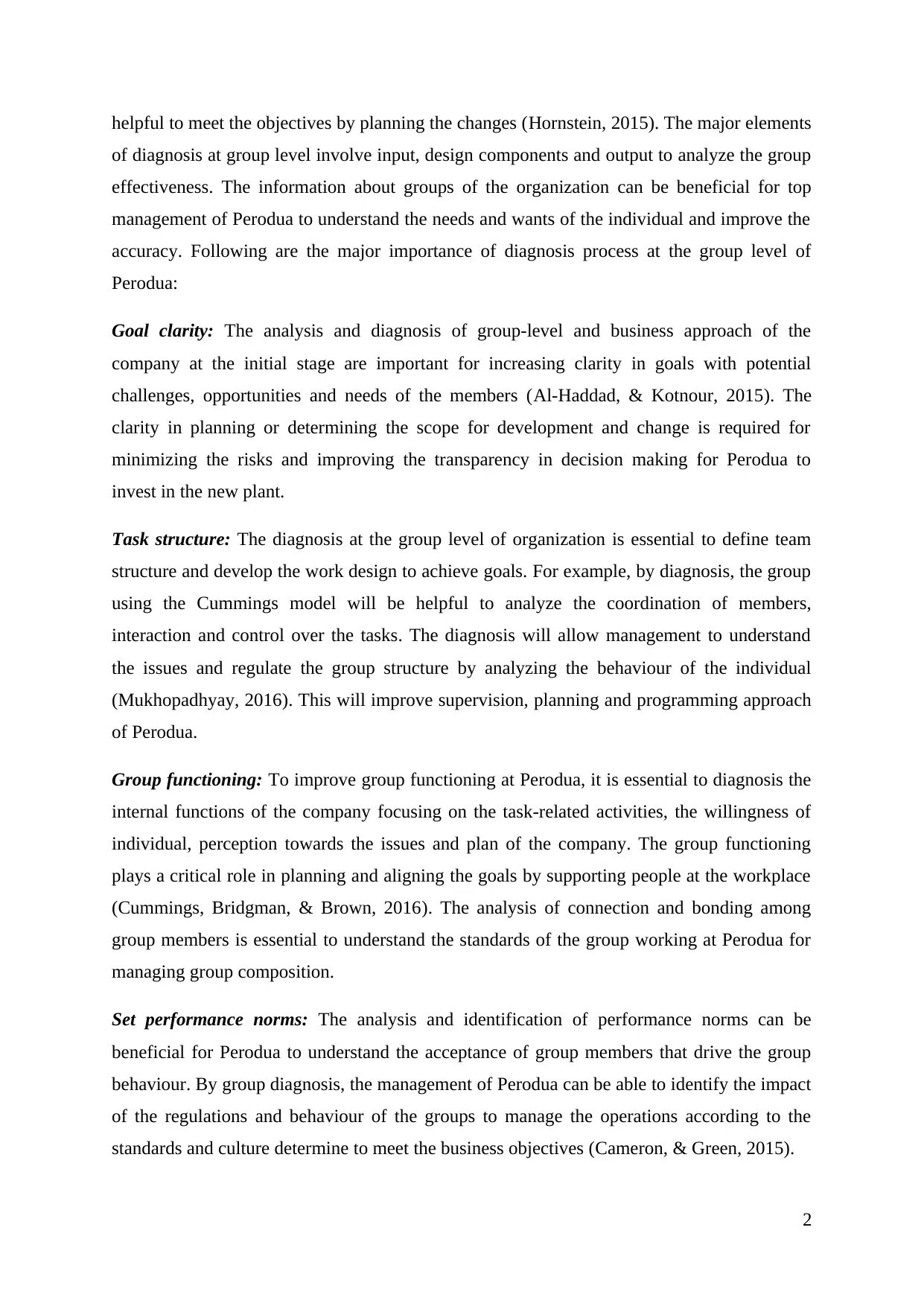
helpful to meet the objectives by planning the changes (Hornstein, 2015). The major elements
of diagnosis at group level involve input, design components and output to analyze the group
effectiveness. The information about groups of the organization can be beneficial for top
management of Perodua to understand the needs and wants of the individual and improve the
accuracy. Following are the major importance of diagnosis process at the group level of
Perodua:
Goal clarity: The analysis and diagnosis of group-level and business approach of the
company at the initial stage are important for increasing clarity in goals with potential
challenges, opportunities and needs of the members (Al-Haddad, & Kotnour, 2015). The
clarity in planning or determining the scope for development and change is required for
minimizing the risks and improving the transparency in decision making for Perodua to
invest in the new plant.
Task structure: The diagnosis at the group level of organization is essential to define team
structure and develop the work design to achieve goals. For example, by diagnosis, the group
using the Cummings model will be helpful to analyze the coordination of members,
interaction and control over the tasks. The diagnosis will allow management to understand
the issues and regulate the group structure by analyzing the behaviour of the individual
(Mukhopadhyay, 2016). This will improve supervision, planning and programming approach
of Perodua.
Group functioning: To improve group functioning at Perodua, it is essential to diagnosis the
internal functions of the company focusing on the task-related activities, the willingness of
individual, perception towards the issues and plan of the company. The group functioning
plays a critical role in planning and aligning the goals by supporting people at the workplace
(Cummings, Bridgman, & Brown, 2016). The analysis of connection and bonding among
group members is essential to understand the standards of the group working at Perodua for
managing group composition.
Set performance norms: The analysis and identification of performance norms can be
beneficial for Perodua to understand the acceptance of group members that drive the group
behaviour. By group diagnosis, the management of Perodua can be able to identify the impact
of the regulations and behaviour of the groups to manage the operations according to the
standards and culture determine to meet the business objectives (Cameron, & Green, 2015).
2
of diagnosis at group level involve input, design components and output to analyze the group
effectiveness. The information about groups of the organization can be beneficial for top
management of Perodua to understand the needs and wants of the individual and improve the
accuracy. Following are the major importance of diagnosis process at the group level of
Perodua:
Goal clarity: The analysis and diagnosis of group-level and business approach of the
company at the initial stage are important for increasing clarity in goals with potential
challenges, opportunities and needs of the members (Al-Haddad, & Kotnour, 2015). The
clarity in planning or determining the scope for development and change is required for
minimizing the risks and improving the transparency in decision making for Perodua to
invest in the new plant.
Task structure: The diagnosis at the group level of organization is essential to define team
structure and develop the work design to achieve goals. For example, by diagnosis, the group
using the Cummings model will be helpful to analyze the coordination of members,
interaction and control over the tasks. The diagnosis will allow management to understand
the issues and regulate the group structure by analyzing the behaviour of the individual
(Mukhopadhyay, 2016). This will improve supervision, planning and programming approach
of Perodua.
Group functioning: To improve group functioning at Perodua, it is essential to diagnosis the
internal functions of the company focusing on the task-related activities, the willingness of
individual, perception towards the issues and plan of the company. The group functioning
plays a critical role in planning and aligning the goals by supporting people at the workplace
(Cummings, Bridgman, & Brown, 2016). The analysis of connection and bonding among
group members is essential to understand the standards of the group working at Perodua for
managing group composition.
Set performance norms: The analysis and identification of performance norms can be
beneficial for Perodua to understand the acceptance of group members that drive the group
behaviour. By group diagnosis, the management of Perodua can be able to identify the impact
of the regulations and behaviour of the groups to manage the operations according to the
standards and culture determine to meet the business objectives (Cameron, & Green, 2015).
2
Paraphrase This Document
Need a fresh take? Get an instant paraphrase of this document with our AI Paraphraser
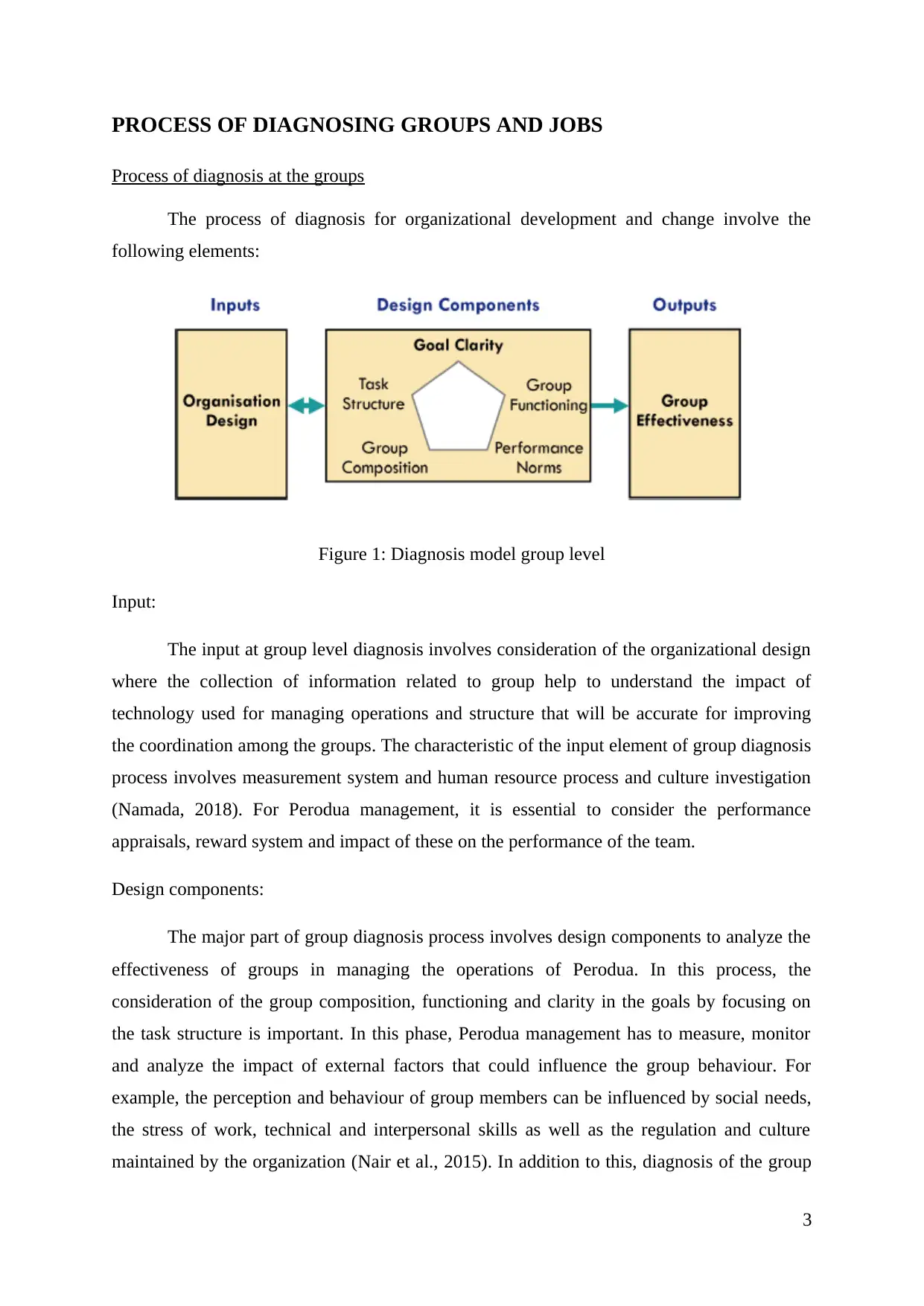
PROCESS OF DIAGNOSING GROUPS AND JOBS
Process of diagnosis at the groups
The process of diagnosis for organizational development and change involve the
following elements:
Figure 1: Diagnosis model group level
Input:
The input at group level diagnosis involves consideration of the organizational design
where the collection of information related to group help to understand the impact of
technology used for managing operations and structure that will be accurate for improving
the coordination among the groups. The characteristic of the input element of group diagnosis
process involves measurement system and human resource process and culture investigation
(Namada, 2018). For Perodua management, it is essential to consider the performance
appraisals, reward system and impact of these on the performance of the team.
Design components:
The major part of group diagnosis process involves design components to analyze the
effectiveness of groups in managing the operations of Perodua. In this process, the
consideration of the group composition, functioning and clarity in the goals by focusing on
the task structure is important. In this phase, Perodua management has to measure, monitor
and analyze the impact of external factors that could influence the group behaviour. For
example, the perception and behaviour of group members can be influenced by social needs,
the stress of work, technical and interpersonal skills as well as the regulation and culture
maintained by the organization (Nair et al., 2015). In addition to this, diagnosis of the group
3
Process of diagnosis at the groups
The process of diagnosis for organizational development and change involve the
following elements:
Figure 1: Diagnosis model group level
Input:
The input at group level diagnosis involves consideration of the organizational design
where the collection of information related to group help to understand the impact of
technology used for managing operations and structure that will be accurate for improving
the coordination among the groups. The characteristic of the input element of group diagnosis
process involves measurement system and human resource process and culture investigation
(Namada, 2018). For Perodua management, it is essential to consider the performance
appraisals, reward system and impact of these on the performance of the team.
Design components:
The major part of group diagnosis process involves design components to analyze the
effectiveness of groups in managing the operations of Perodua. In this process, the
consideration of the group composition, functioning and clarity in the goals by focusing on
the task structure is important. In this phase, Perodua management has to measure, monitor
and analyze the impact of external factors that could influence the group behaviour. For
example, the perception and behaviour of group members can be influenced by social needs,
the stress of work, technical and interpersonal skills as well as the regulation and culture
maintained by the organization (Nair et al., 2015). In addition to this, diagnosis of the group
3
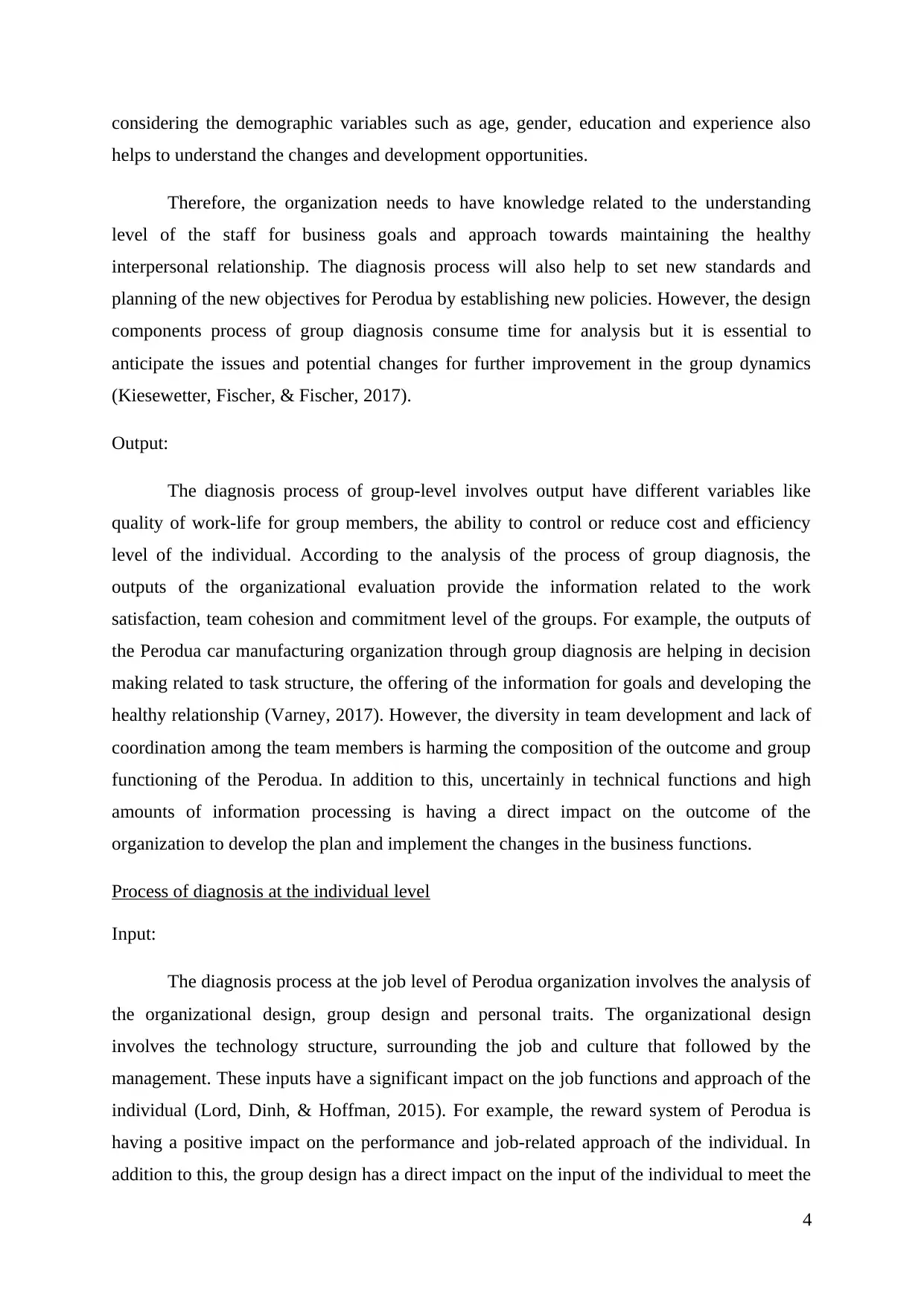
considering the demographic variables such as age, gender, education and experience also
helps to understand the changes and development opportunities.
Therefore, the organization needs to have knowledge related to the understanding
level of the staff for business goals and approach towards maintaining the healthy
interpersonal relationship. The diagnosis process will also help to set new standards and
planning of the new objectives for Perodua by establishing new policies. However, the design
components process of group diagnosis consume time for analysis but it is essential to
anticipate the issues and potential changes for further improvement in the group dynamics
(Kiesewetter, Fischer, & Fischer, 2017).
Output:
The diagnosis process of group-level involves output have different variables like
quality of work-life for group members, the ability to control or reduce cost and efficiency
level of the individual. According to the analysis of the process of group diagnosis, the
outputs of the organizational evaluation provide the information related to the work
satisfaction, team cohesion and commitment level of the groups. For example, the outputs of
the Perodua car manufacturing organization through group diagnosis are helping in decision
making related to task structure, the offering of the information for goals and developing the
healthy relationship (Varney, 2017). However, the diversity in team development and lack of
coordination among the team members is harming the composition of the outcome and group
functioning of the Perodua. In addition to this, uncertainly in technical functions and high
amounts of information processing is having a direct impact on the outcome of the
organization to develop the plan and implement the changes in the business functions.
Process of diagnosis at the individual level
Input:
The diagnosis process at the job level of Perodua organization involves the analysis of
the organizational design, group design and personal traits. The organizational design
involves the technology structure, surrounding the job and culture that followed by the
management. These inputs have a significant impact on the job functions and approach of the
individual (Lord, Dinh, & Hoffman, 2015). For example, the reward system of Perodua is
having a positive impact on the performance and job-related approach of the individual. In
addition to this, the group design has a direct impact on the input of the individual to meet the
4
helps to understand the changes and development opportunities.
Therefore, the organization needs to have knowledge related to the understanding
level of the staff for business goals and approach towards maintaining the healthy
interpersonal relationship. The diagnosis process will also help to set new standards and
planning of the new objectives for Perodua by establishing new policies. However, the design
components process of group diagnosis consume time for analysis but it is essential to
anticipate the issues and potential changes for further improvement in the group dynamics
(Kiesewetter, Fischer, & Fischer, 2017).
Output:
The diagnosis process of group-level involves output have different variables like
quality of work-life for group members, the ability to control or reduce cost and efficiency
level of the individual. According to the analysis of the process of group diagnosis, the
outputs of the organizational evaluation provide the information related to the work
satisfaction, team cohesion and commitment level of the groups. For example, the outputs of
the Perodua car manufacturing organization through group diagnosis are helping in decision
making related to task structure, the offering of the information for goals and developing the
healthy relationship (Varney, 2017). However, the diversity in team development and lack of
coordination among the team members is harming the composition of the outcome and group
functioning of the Perodua. In addition to this, uncertainly in technical functions and high
amounts of information processing is having a direct impact on the outcome of the
organization to develop the plan and implement the changes in the business functions.
Process of diagnosis at the individual level
Input:
The diagnosis process at the job level of Perodua organization involves the analysis of
the organizational design, group design and personal traits. The organizational design
involves the technology structure, surrounding the job and culture that followed by the
management. These inputs have a significant impact on the job functions and approach of the
individual (Lord, Dinh, & Hoffman, 2015). For example, the reward system of Perodua is
having a positive impact on the performance and job-related approach of the individual. In
addition to this, the group design has a direct impact on the input of the individual to meet the
4
⊘ This is a preview!⊘
Do you want full access?
Subscribe today to unlock all pages.

Trusted by 1+ million students worldwide
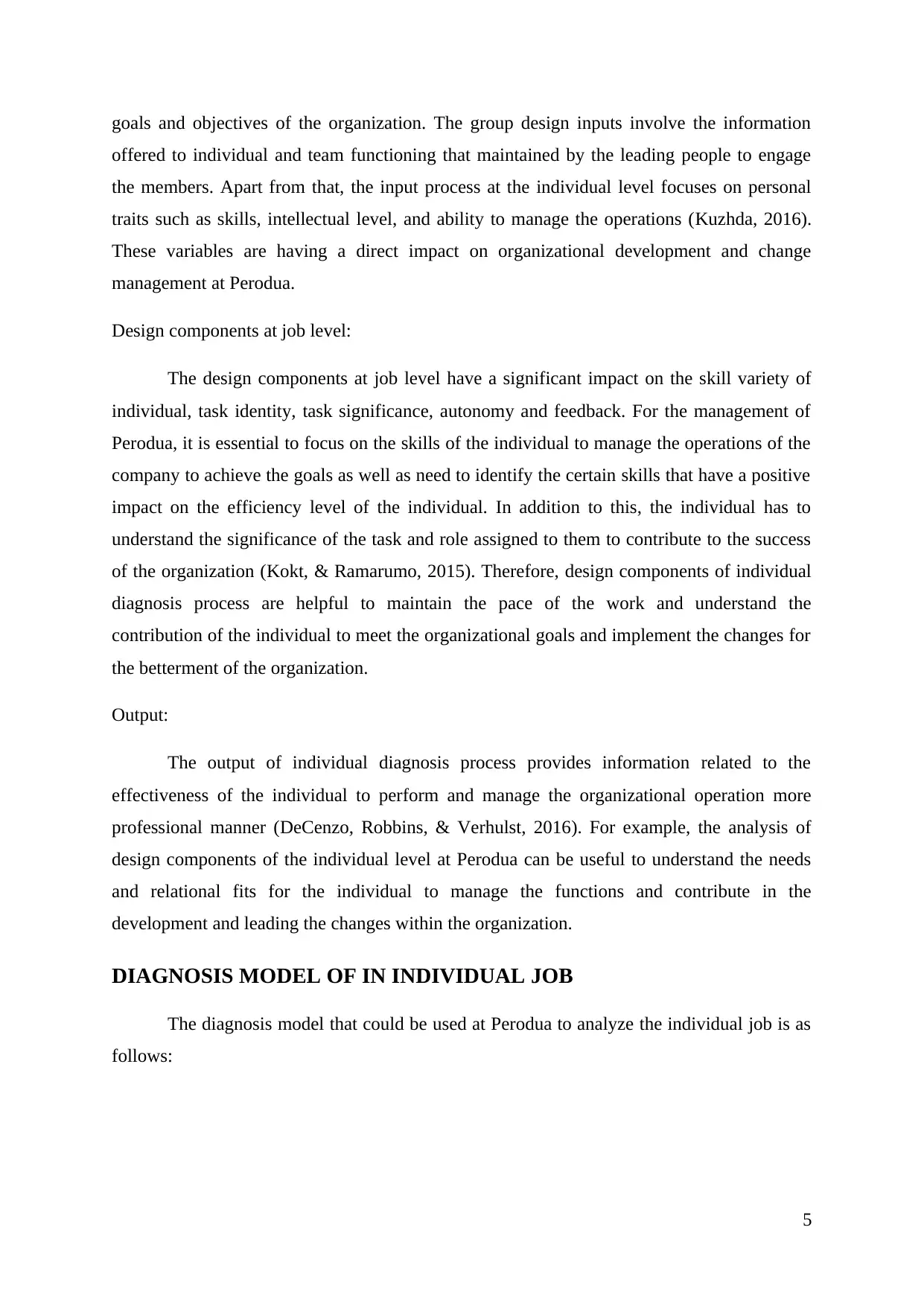
goals and objectives of the organization. The group design inputs involve the information
offered to individual and team functioning that maintained by the leading people to engage
the members. Apart from that, the input process at the individual level focuses on personal
traits such as skills, intellectual level, and ability to manage the operations (Kuzhda, 2016).
These variables are having a direct impact on organizational development and change
management at Perodua.
Design components at job level:
The design components at job level have a significant impact on the skill variety of
individual, task identity, task significance, autonomy and feedback. For the management of
Perodua, it is essential to focus on the skills of the individual to manage the operations of the
company to achieve the goals as well as need to identify the certain skills that have a positive
impact on the efficiency level of the individual. In addition to this, the individual has to
understand the significance of the task and role assigned to them to contribute to the success
of the organization (Kokt, & Ramarumo, 2015). Therefore, design components of individual
diagnosis process are helpful to maintain the pace of the work and understand the
contribution of the individual to meet the organizational goals and implement the changes for
the betterment of the organization.
Output:
The output of individual diagnosis process provides information related to the
effectiveness of the individual to perform and manage the organizational operation more
professional manner (DeCenzo, Robbins, & Verhulst, 2016). For example, the analysis of
design components of the individual level at Perodua can be useful to understand the needs
and relational fits for the individual to manage the functions and contribute in the
development and leading the changes within the organization.
DIAGNOSIS MODEL OF IN INDIVIDUAL JOB
The diagnosis model that could be used at Perodua to analyze the individual job is as
follows:
5
offered to individual and team functioning that maintained by the leading people to engage
the members. Apart from that, the input process at the individual level focuses on personal
traits such as skills, intellectual level, and ability to manage the operations (Kuzhda, 2016).
These variables are having a direct impact on organizational development and change
management at Perodua.
Design components at job level:
The design components at job level have a significant impact on the skill variety of
individual, task identity, task significance, autonomy and feedback. For the management of
Perodua, it is essential to focus on the skills of the individual to manage the operations of the
company to achieve the goals as well as need to identify the certain skills that have a positive
impact on the efficiency level of the individual. In addition to this, the individual has to
understand the significance of the task and role assigned to them to contribute to the success
of the organization (Kokt, & Ramarumo, 2015). Therefore, design components of individual
diagnosis process are helpful to maintain the pace of the work and understand the
contribution of the individual to meet the organizational goals and implement the changes for
the betterment of the organization.
Output:
The output of individual diagnosis process provides information related to the
effectiveness of the individual to perform and manage the organizational operation more
professional manner (DeCenzo, Robbins, & Verhulst, 2016). For example, the analysis of
design components of the individual level at Perodua can be useful to understand the needs
and relational fits for the individual to manage the functions and contribute in the
development and leading the changes within the organization.
DIAGNOSIS MODEL OF IN INDIVIDUAL JOB
The diagnosis model that could be used at Perodua to analyze the individual job is as
follows:
5
Paraphrase This Document
Need a fresh take? Get an instant paraphrase of this document with our AI Paraphraser
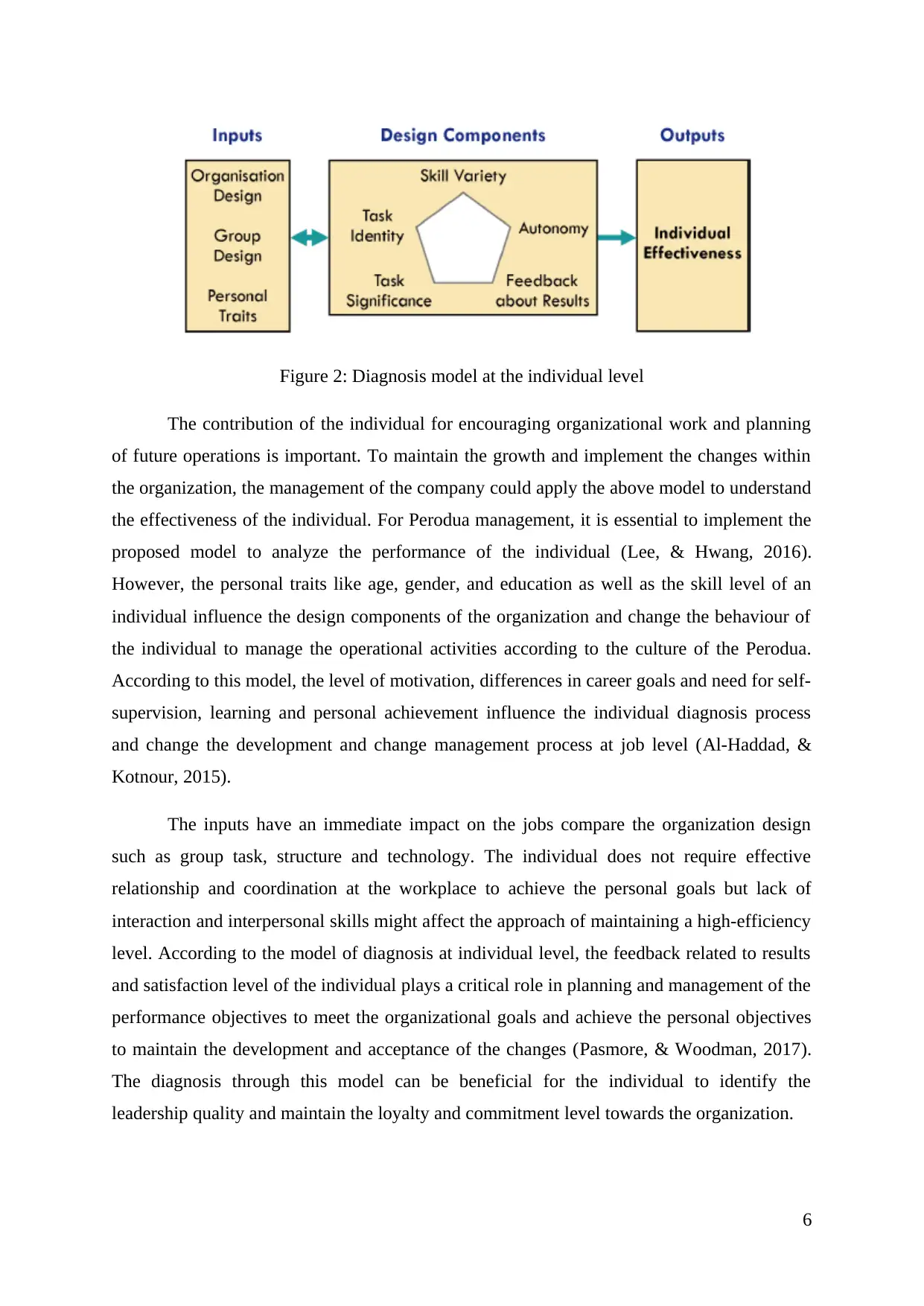
Figure 2: Diagnosis model at the individual level
The contribution of the individual for encouraging organizational work and planning
of future operations is important. To maintain the growth and implement the changes within
the organization, the management of the company could apply the above model to understand
the effectiveness of the individual. For Perodua management, it is essential to implement the
proposed model to analyze the performance of the individual (Lee, & Hwang, 2016).
However, the personal traits like age, gender, and education as well as the skill level of an
individual influence the design components of the organization and change the behaviour of
the individual to manage the operational activities according to the culture of the Perodua.
According to this model, the level of motivation, differences in career goals and need for self-
supervision, learning and personal achievement influence the individual diagnosis process
and change the development and change management process at job level (Al-Haddad, &
Kotnour, 2015).
The inputs have an immediate impact on the jobs compare the organization design
such as group task, structure and technology. The individual does not require effective
relationship and coordination at the workplace to achieve the personal goals but lack of
interaction and interpersonal skills might affect the approach of maintaining a high-efficiency
level. According to the model of diagnosis at individual level, the feedback related to results
and satisfaction level of the individual plays a critical role in planning and management of the
performance objectives to meet the organizational goals and achieve the personal objectives
to maintain the development and acceptance of the changes (Pasmore, & Woodman, 2017).
The diagnosis through this model can be beneficial for the individual to identify the
leadership quality and maintain the loyalty and commitment level towards the organization.
6
The contribution of the individual for encouraging organizational work and planning
of future operations is important. To maintain the growth and implement the changes within
the organization, the management of the company could apply the above model to understand
the effectiveness of the individual. For Perodua management, it is essential to implement the
proposed model to analyze the performance of the individual (Lee, & Hwang, 2016).
However, the personal traits like age, gender, and education as well as the skill level of an
individual influence the design components of the organization and change the behaviour of
the individual to manage the operational activities according to the culture of the Perodua.
According to this model, the level of motivation, differences in career goals and need for self-
supervision, learning and personal achievement influence the individual diagnosis process
and change the development and change management process at job level (Al-Haddad, &
Kotnour, 2015).
The inputs have an immediate impact on the jobs compare the organization design
such as group task, structure and technology. The individual does not require effective
relationship and coordination at the workplace to achieve the personal goals but lack of
interaction and interpersonal skills might affect the approach of maintaining a high-efficiency
level. According to the model of diagnosis at individual level, the feedback related to results
and satisfaction level of the individual plays a critical role in planning and management of the
performance objectives to meet the organizational goals and achieve the personal objectives
to maintain the development and acceptance of the changes (Pasmore, & Woodman, 2017).
The diagnosis through this model can be beneficial for the individual to identify the
leadership quality and maintain the loyalty and commitment level towards the organization.
6
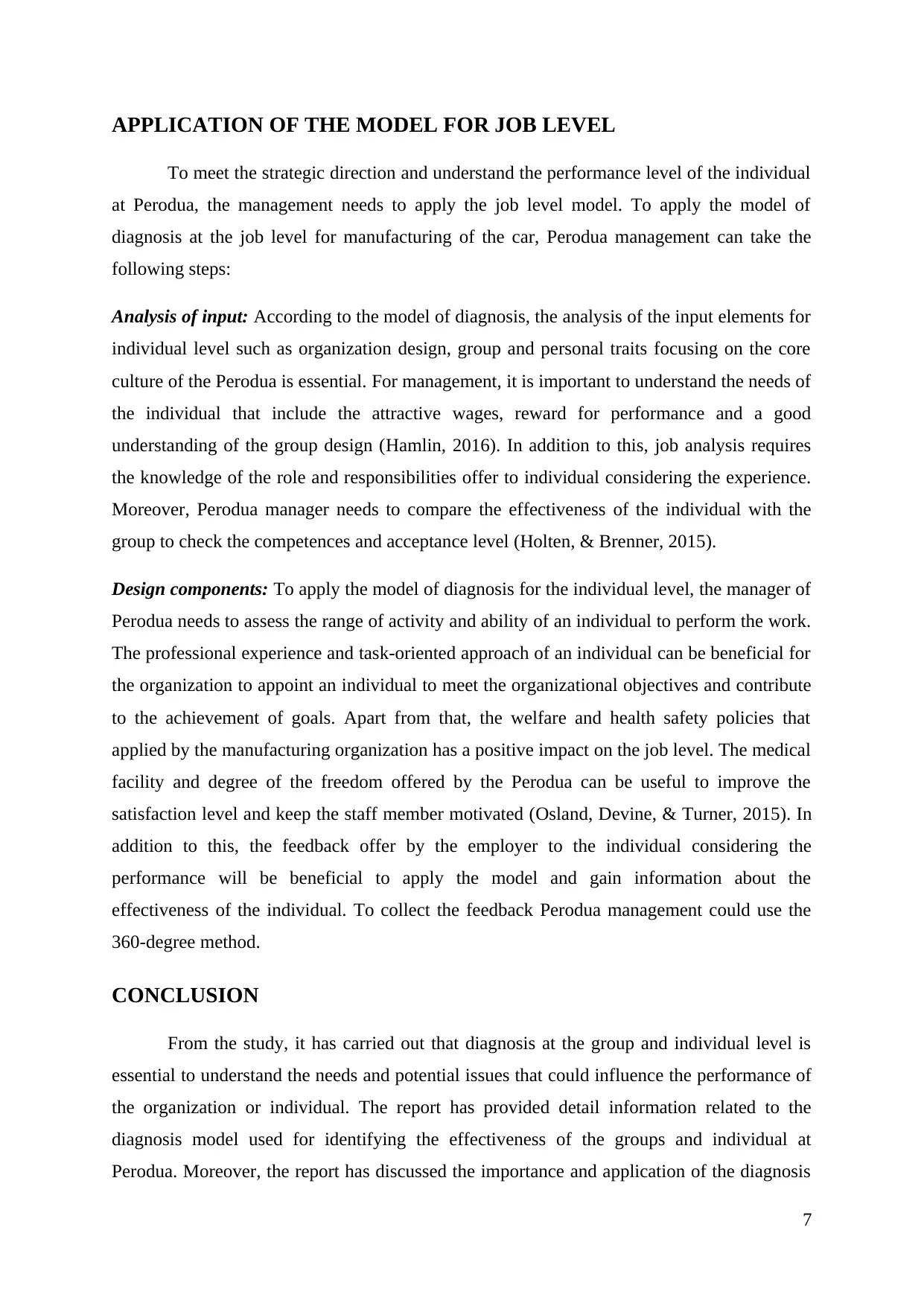
APPLICATION OF THE MODEL FOR JOB LEVEL
To meet the strategic direction and understand the performance level of the individual
at Perodua, the management needs to apply the job level model. To apply the model of
diagnosis at the job level for manufacturing of the car, Perodua management can take the
following steps:
Analysis of input: According to the model of diagnosis, the analysis of the input elements for
individual level such as organization design, group and personal traits focusing on the core
culture of the Perodua is essential. For management, it is important to understand the needs of
the individual that include the attractive wages, reward for performance and a good
understanding of the group design (Hamlin, 2016). In addition to this, job analysis requires
the knowledge of the role and responsibilities offer to individual considering the experience.
Moreover, Perodua manager needs to compare the effectiveness of the individual with the
group to check the competences and acceptance level (Holten, & Brenner, 2015).
Design components: To apply the model of diagnosis for the individual level, the manager of
Perodua needs to assess the range of activity and ability of an individual to perform the work.
The professional experience and task-oriented approach of an individual can be beneficial for
the organization to appoint an individual to meet the organizational objectives and contribute
to the achievement of goals. Apart from that, the welfare and health safety policies that
applied by the manufacturing organization has a positive impact on the job level. The medical
facility and degree of the freedom offered by the Perodua can be useful to improve the
satisfaction level and keep the staff member motivated (Osland, Devine, & Turner, 2015). In
addition to this, the feedback offer by the employer to the individual considering the
performance will be beneficial to apply the model and gain information about the
effectiveness of the individual. To collect the feedback Perodua management could use the
360-degree method.
CONCLUSION
From the study, it has carried out that diagnosis at the group and individual level is
essential to understand the needs and potential issues that could influence the performance of
the organization or individual. The report has provided detail information related to the
diagnosis model used for identifying the effectiveness of the groups and individual at
Perodua. Moreover, the report has discussed the importance and application of the diagnosis
7
To meet the strategic direction and understand the performance level of the individual
at Perodua, the management needs to apply the job level model. To apply the model of
diagnosis at the job level for manufacturing of the car, Perodua management can take the
following steps:
Analysis of input: According to the model of diagnosis, the analysis of the input elements for
individual level such as organization design, group and personal traits focusing on the core
culture of the Perodua is essential. For management, it is important to understand the needs of
the individual that include the attractive wages, reward for performance and a good
understanding of the group design (Hamlin, 2016). In addition to this, job analysis requires
the knowledge of the role and responsibilities offer to individual considering the experience.
Moreover, Perodua manager needs to compare the effectiveness of the individual with the
group to check the competences and acceptance level (Holten, & Brenner, 2015).
Design components: To apply the model of diagnosis for the individual level, the manager of
Perodua needs to assess the range of activity and ability of an individual to perform the work.
The professional experience and task-oriented approach of an individual can be beneficial for
the organization to appoint an individual to meet the organizational objectives and contribute
to the achievement of goals. Apart from that, the welfare and health safety policies that
applied by the manufacturing organization has a positive impact on the job level. The medical
facility and degree of the freedom offered by the Perodua can be useful to improve the
satisfaction level and keep the staff member motivated (Osland, Devine, & Turner, 2015). In
addition to this, the feedback offer by the employer to the individual considering the
performance will be beneficial to apply the model and gain information about the
effectiveness of the individual. To collect the feedback Perodua management could use the
360-degree method.
CONCLUSION
From the study, it has carried out that diagnosis at the group and individual level is
essential to understand the needs and potential issues that could influence the performance of
the organization or individual. The report has provided detail information related to the
diagnosis model used for identifying the effectiveness of the groups and individual at
Perodua. Moreover, the report has discussed the importance and application of the diagnosis
7
⊘ This is a preview!⊘
Do you want full access?
Subscribe today to unlock all pages.

Trusted by 1+ million students worldwide
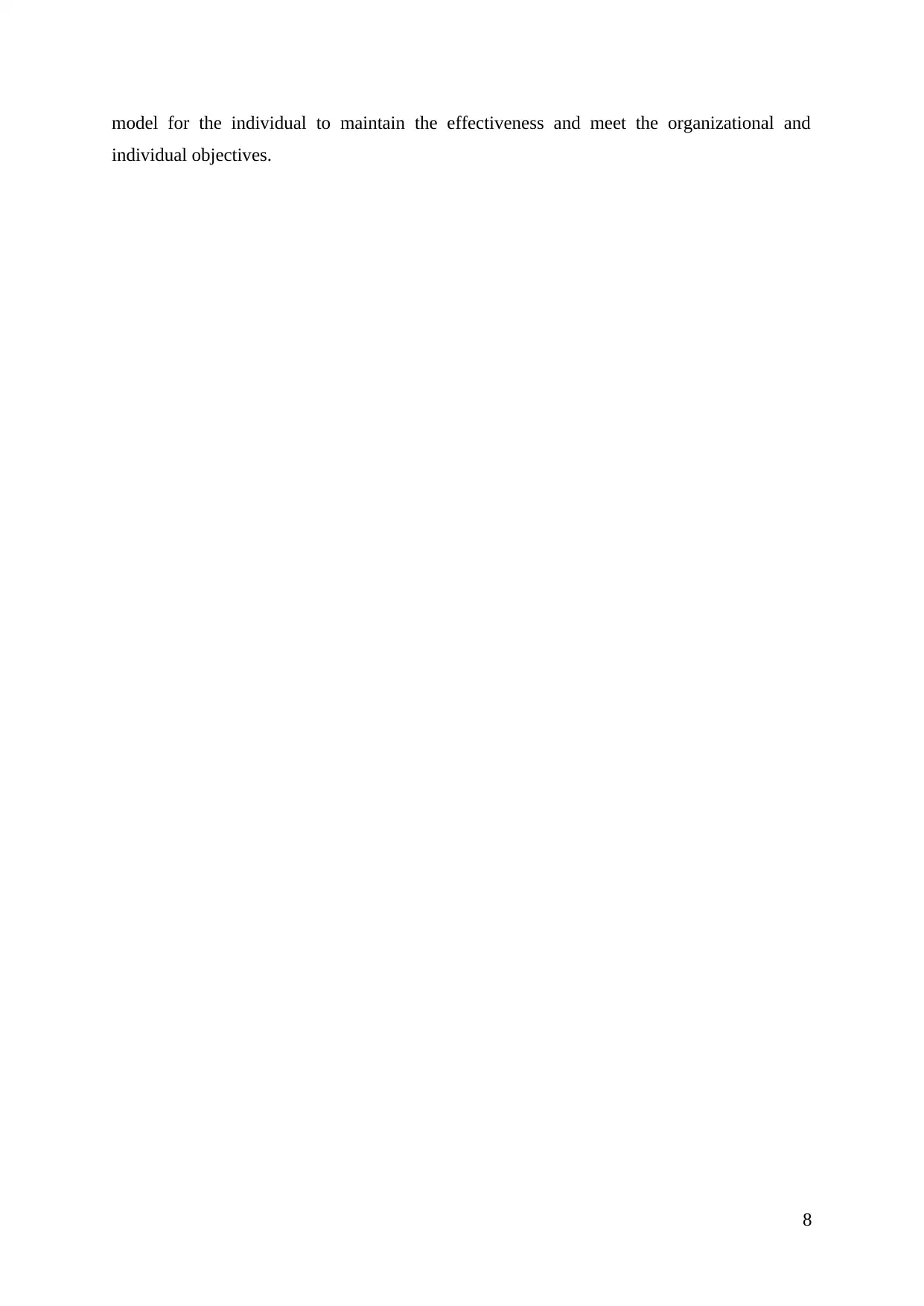
model for the individual to maintain the effectiveness and meet the organizational and
individual objectives.
8
individual objectives.
8
Paraphrase This Document
Need a fresh take? Get an instant paraphrase of this document with our AI Paraphraser
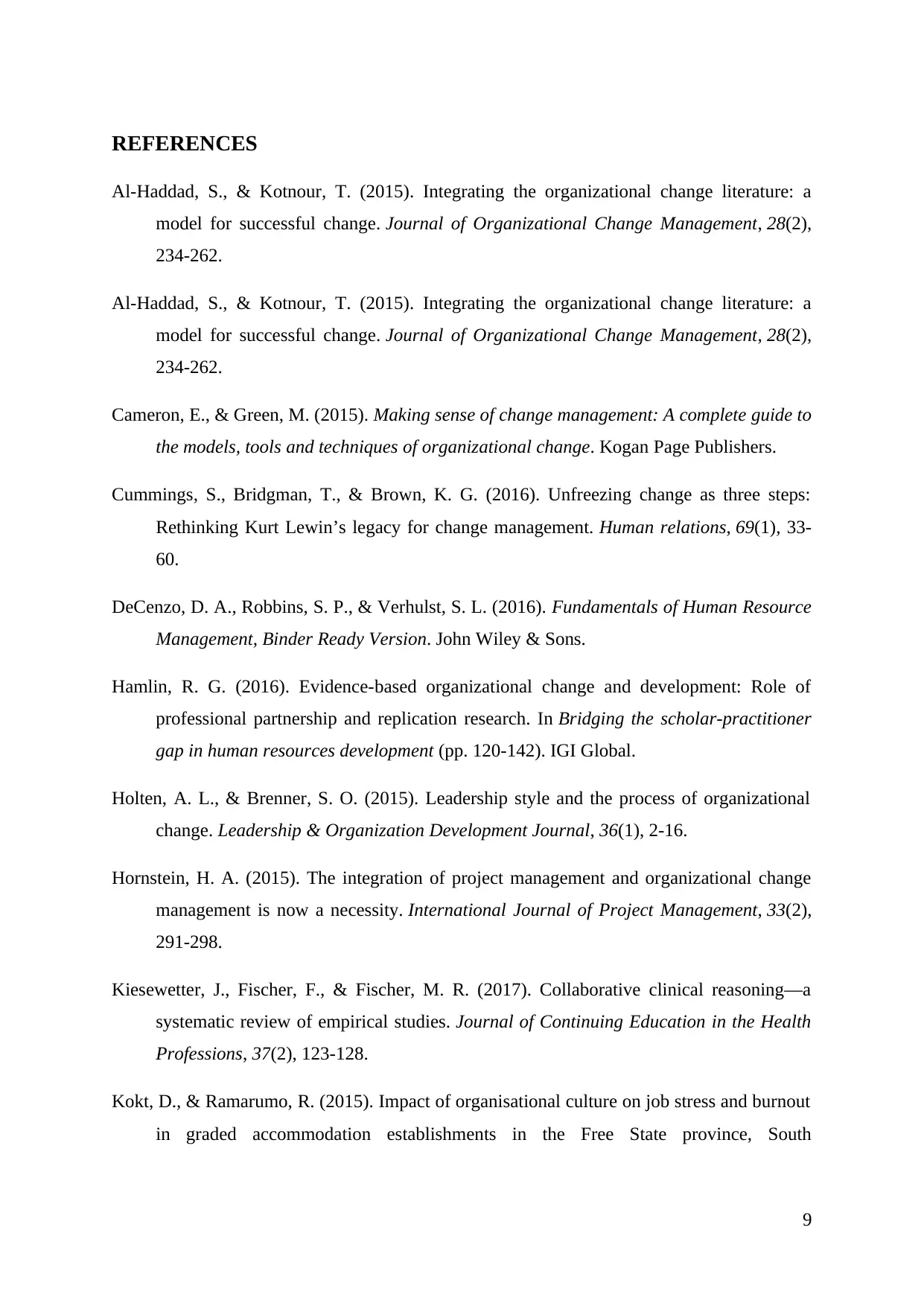
REFERENCES
Al-Haddad, S., & Kotnour, T. (2015). Integrating the organizational change literature: a
model for successful change. Journal of Organizational Change Management, 28(2),
234-262.
Al-Haddad, S., & Kotnour, T. (2015). Integrating the organizational change literature: a
model for successful change. Journal of Organizational Change Management, 28(2),
234-262.
Cameron, E., & Green, M. (2015). Making sense of change management: A complete guide to
the models, tools and techniques of organizational change. Kogan Page Publishers.
Cummings, S., Bridgman, T., & Brown, K. G. (2016). Unfreezing change as three steps:
Rethinking Kurt Lewin’s legacy for change management. Human relations, 69(1), 33-
60.
DeCenzo, D. A., Robbins, S. P., & Verhulst, S. L. (2016). Fundamentals of Human Resource
Management, Binder Ready Version. John Wiley & Sons.
Hamlin, R. G. (2016). Evidence-based organizational change and development: Role of
professional partnership and replication research. In Bridging the scholar-practitioner
gap in human resources development (pp. 120-142). IGI Global.
Holten, A. L., & Brenner, S. O. (2015). Leadership style and the process of organizational
change. Leadership & Organization Development Journal, 36(1), 2-16.
Hornstein, H. A. (2015). The integration of project management and organizational change
management is now a necessity. International Journal of Project Management, 33(2),
291-298.
Kiesewetter, J., Fischer, F., & Fischer, M. R. (2017). Collaborative clinical reasoning—a
systematic review of empirical studies. Journal of Continuing Education in the Health
Professions, 37(2), 123-128.
Kokt, D., & Ramarumo, R. (2015). Impact of organisational culture on job stress and burnout
in graded accommodation establishments in the Free State province, South
9
Al-Haddad, S., & Kotnour, T. (2015). Integrating the organizational change literature: a
model for successful change. Journal of Organizational Change Management, 28(2),
234-262.
Al-Haddad, S., & Kotnour, T. (2015). Integrating the organizational change literature: a
model for successful change. Journal of Organizational Change Management, 28(2),
234-262.
Cameron, E., & Green, M. (2015). Making sense of change management: A complete guide to
the models, tools and techniques of organizational change. Kogan Page Publishers.
Cummings, S., Bridgman, T., & Brown, K. G. (2016). Unfreezing change as three steps:
Rethinking Kurt Lewin’s legacy for change management. Human relations, 69(1), 33-
60.
DeCenzo, D. A., Robbins, S. P., & Verhulst, S. L. (2016). Fundamentals of Human Resource
Management, Binder Ready Version. John Wiley & Sons.
Hamlin, R. G. (2016). Evidence-based organizational change and development: Role of
professional partnership and replication research. In Bridging the scholar-practitioner
gap in human resources development (pp. 120-142). IGI Global.
Holten, A. L., & Brenner, S. O. (2015). Leadership style and the process of organizational
change. Leadership & Organization Development Journal, 36(1), 2-16.
Hornstein, H. A. (2015). The integration of project management and organizational change
management is now a necessity. International Journal of Project Management, 33(2),
291-298.
Kiesewetter, J., Fischer, F., & Fischer, M. R. (2017). Collaborative clinical reasoning—a
systematic review of empirical studies. Journal of Continuing Education in the Health
Professions, 37(2), 123-128.
Kokt, D., & Ramarumo, R. (2015). Impact of organisational culture on job stress and burnout
in graded accommodation establishments in the Free State province, South
9
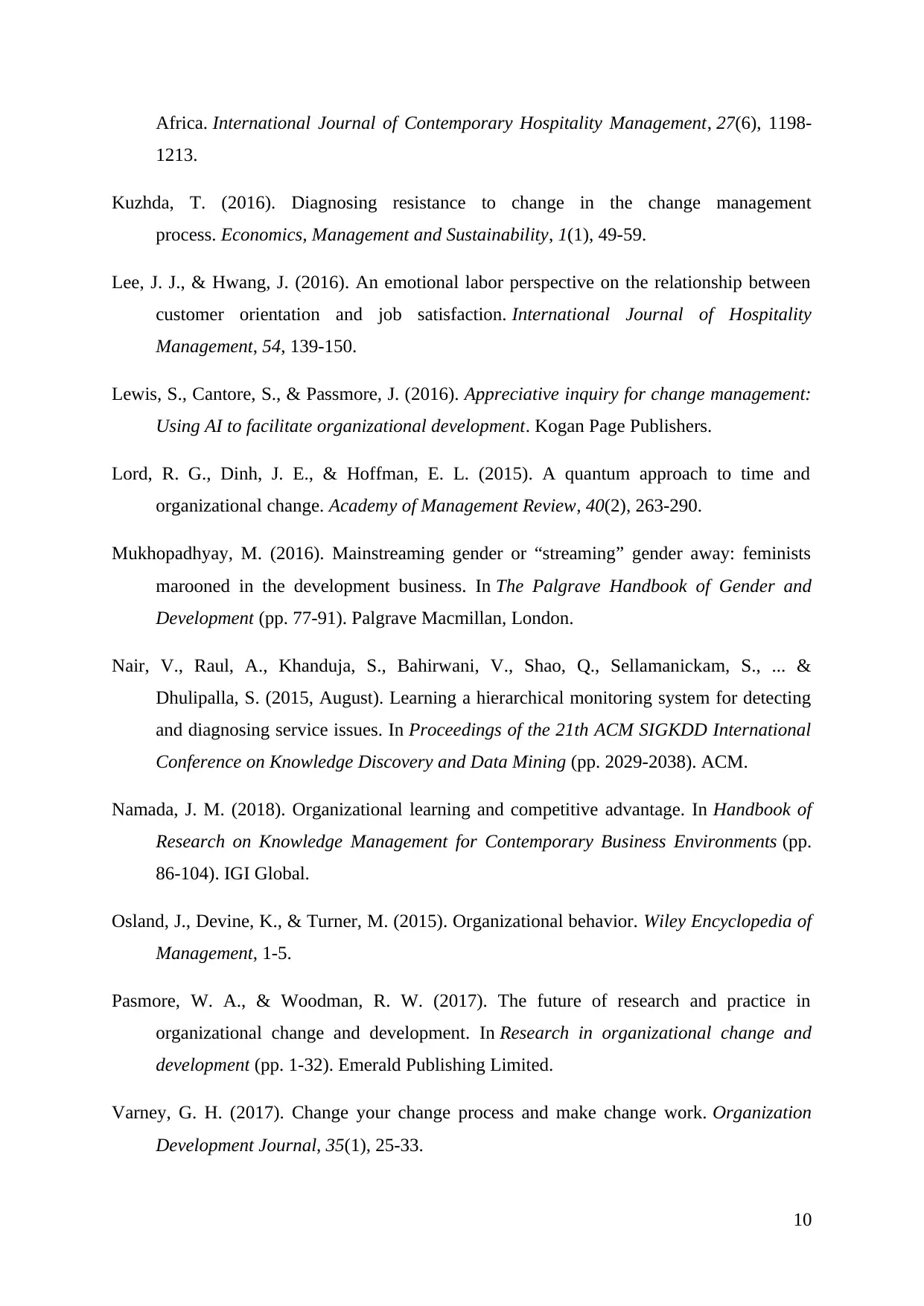
Africa. International Journal of Contemporary Hospitality Management, 27(6), 1198-
1213.
Kuzhda, T. (2016). Diagnosing resistance to change in the change management
process. Economics, Management and Sustainability, 1(1), 49-59.
Lee, J. J., & Hwang, J. (2016). An emotional labor perspective on the relationship between
customer orientation and job satisfaction. International Journal of Hospitality
Management, 54, 139-150.
Lewis, S., Cantore, S., & Passmore, J. (2016). Appreciative inquiry for change management:
Using AI to facilitate organizational development. Kogan Page Publishers.
Lord, R. G., Dinh, J. E., & Hoffman, E. L. (2015). A quantum approach to time and
organizational change. Academy of Management Review, 40(2), 263-290.
Mukhopadhyay, M. (2016). Mainstreaming gender or “streaming” gender away: feminists
marooned in the development business. In The Palgrave Handbook of Gender and
Development (pp. 77-91). Palgrave Macmillan, London.
Nair, V., Raul, A., Khanduja, S., Bahirwani, V., Shao, Q., Sellamanickam, S., ... &
Dhulipalla, S. (2015, August). Learning a hierarchical monitoring system for detecting
and diagnosing service issues. In Proceedings of the 21th ACM SIGKDD International
Conference on Knowledge Discovery and Data Mining (pp. 2029-2038). ACM.
Namada, J. M. (2018). Organizational learning and competitive advantage. In Handbook of
Research on Knowledge Management for Contemporary Business Environments (pp.
86-104). IGI Global.
Osland, J., Devine, K., & Turner, M. (2015). Organizational behavior. Wiley Encyclopedia of
Management, 1-5.
Pasmore, W. A., & Woodman, R. W. (2017). The future of research and practice in
organizational change and development. In Research in organizational change and
development (pp. 1-32). Emerald Publishing Limited.
Varney, G. H. (2017). Change your change process and make change work. Organization
Development Journal, 35(1), 25-33.
10
1213.
Kuzhda, T. (2016). Diagnosing resistance to change in the change management
process. Economics, Management and Sustainability, 1(1), 49-59.
Lee, J. J., & Hwang, J. (2016). An emotional labor perspective on the relationship between
customer orientation and job satisfaction. International Journal of Hospitality
Management, 54, 139-150.
Lewis, S., Cantore, S., & Passmore, J. (2016). Appreciative inquiry for change management:
Using AI to facilitate organizational development. Kogan Page Publishers.
Lord, R. G., Dinh, J. E., & Hoffman, E. L. (2015). A quantum approach to time and
organizational change. Academy of Management Review, 40(2), 263-290.
Mukhopadhyay, M. (2016). Mainstreaming gender or “streaming” gender away: feminists
marooned in the development business. In The Palgrave Handbook of Gender and
Development (pp. 77-91). Palgrave Macmillan, London.
Nair, V., Raul, A., Khanduja, S., Bahirwani, V., Shao, Q., Sellamanickam, S., ... &
Dhulipalla, S. (2015, August). Learning a hierarchical monitoring system for detecting
and diagnosing service issues. In Proceedings of the 21th ACM SIGKDD International
Conference on Knowledge Discovery and Data Mining (pp. 2029-2038). ACM.
Namada, J. M. (2018). Organizational learning and competitive advantage. In Handbook of
Research on Knowledge Management for Contemporary Business Environments (pp.
86-104). IGI Global.
Osland, J., Devine, K., & Turner, M. (2015). Organizational behavior. Wiley Encyclopedia of
Management, 1-5.
Pasmore, W. A., & Woodman, R. W. (2017). The future of research and practice in
organizational change and development. In Research in organizational change and
development (pp. 1-32). Emerald Publishing Limited.
Varney, G. H. (2017). Change your change process and make change work. Organization
Development Journal, 35(1), 25-33.
10
⊘ This is a preview!⊘
Do you want full access?
Subscribe today to unlock all pages.

Trusted by 1+ million students worldwide
1 out of 13
Related Documents
Your All-in-One AI-Powered Toolkit for Academic Success.
+13062052269
info@desklib.com
Available 24*7 on WhatsApp / Email
![[object Object]](/_next/static/media/star-bottom.7253800d.svg)
Unlock your academic potential
Copyright © 2020–2025 A2Z Services. All Rights Reserved. Developed and managed by ZUCOL.





